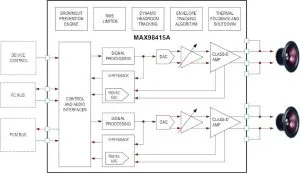MAX98415A and MAX98425A are similar, and both including envelope tracking control that saves power by instructing an external dc-dc converter to provide the amplifiers main power input with just enough voltage for clean output signals.
The difference between the two is that MAX98415A includes extra hardware (‘ Vfeedback’ and ‘Isense ADC’ in diagram) to gather data and transmit it to an external host MCU so that the host can run speaker protection algorithms.
Inputs are digital up to 192kHz, and output power for for 1% THD+N from the MAX98415A is 27W stereo into 8Ω from 22V, or 19W into 4Ω from 14V. MAX98425A deliver ~1W in each circumstance.
For either divice, THD+N for 2W into 8Ω is -81.1dB at 1kHz.
There is a great deal more in these ICs in addition to the two main signal chain –
For example, a dynamic headroom tracking block monitors the main power rail and attempts to minimise audible artifacts during power dips by compressing the audio signal or limiting it.
Beyond this and intended for battery-powered systems, a ‘brown-out prevention engine’ looks for deep dips in the incoming supply and briefly decreases current draw to preserve the rail for other systems sharing it.
Thermal fold-back can be enabled to automatically reduce output power when the temperature exceeds an adjustable threshold. “This allows for uninterrupted music playback even at high ambient temperatures,” said ADI.
Inputs are PCM for audio data and I2C control.
Most of the features above are deeply programmable and there are many other features – internal tone and pink noise generators to name but two.
Four power rails are needed in total: 1.8V for digital logic, 1.8V for the internal analogue, 2.4 to 5.5V battery connection (there is no charger) and the main 3 to 22V output stage power rail.
Packaging is 3.4 x 2.2mm 0.4mm pitch 40bump WLP.
The datasheet is worth a brows just to see how mich is on these ICs.
There was an unusual Class-D audio amplifier at ISSCC this year that boosted its own output voltage

